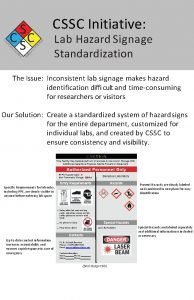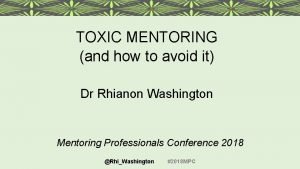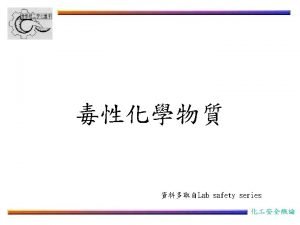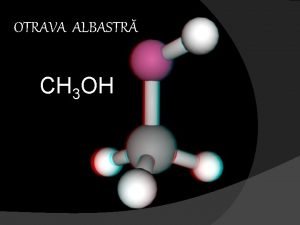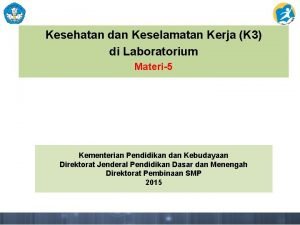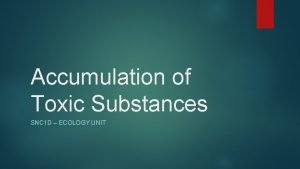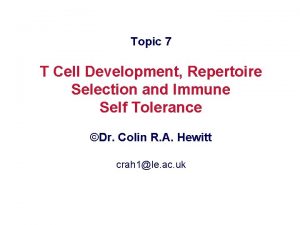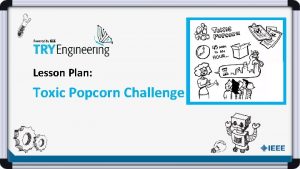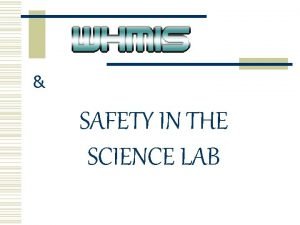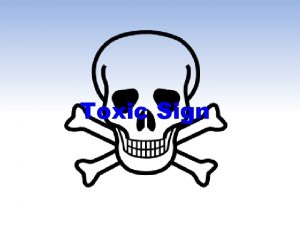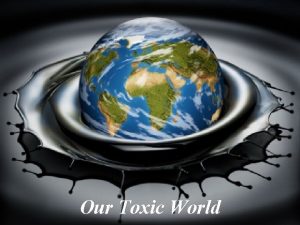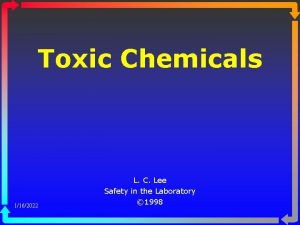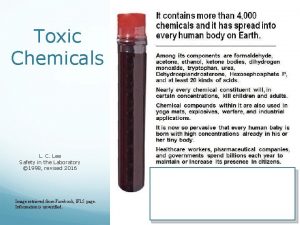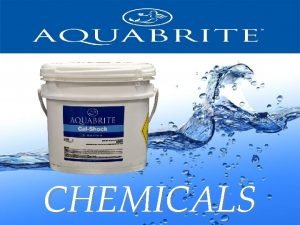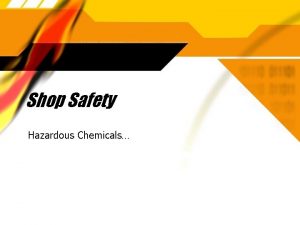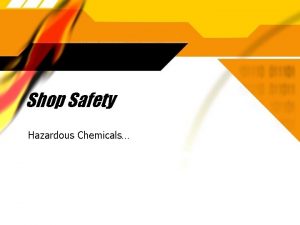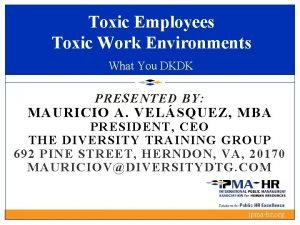Toxic Chemicals 9152020 L C Lee Safety in














- Slides: 14

Toxic Chemicals 9/15/2020 L. C. Lee Safety in the Laboratory © 1998

What is a Toxic Chemical? ßAny chemical which, when ingested, inhaled, absorbed or injected into the body, in relatively small amounts, by its chemical action, may cause damage to structure or disturbance to function ß ~ From Dorland’s Medical Dictionary. 9/15/2020

5 Categories of Toxic Chemicals ß Toxics - poisons; usually cause systemic damage ß Reactives - react chemically with everyday substances ß Corrosives - corrode substances including flesh ß Flammables - burn ß Compressed gases - very high pressure (Scuba cylinder) ßMay or may not contain a toxic or flammable gas 9/15/2020

4 Routes of Chemical Entry ßIngestion - via the mouth ßInhalation - through the lungs ßInjection - via a puncture wound ßAbsorption - skin contact

Prevention of Chemical Entry: ßDo not eat or put anything in your mouth while working in lab. NO gum, candy. ßDo not chew your pen or fingernails. ßWash hands before leaving ßHandle glassware carefully ßDress appropriately ßWEAR GOGGLES AND APRON

3 types of damage caused by a toxic chemical: ßDamage to biological structure ßExample: ßDisturbance of biological function ßExample: ßDamaging both structure and function ßExample: 9/15/2020

Damage…. . . ßLocal - affects only the exposed part. ßContact through absorption, inhalation, ingestion, or injection ßSystemic - effect of a substance after absorption the bloodstream. ßAbsorption may take place through the skin, stomach, or lungs. 9/15/2020

Acute or Chronic damage? ßAcute toxicity - victim becomes ill or injured after “short exposure” ßsometimes just a few moments ßChronic toxicity - effects of a toxicant on a body over a long period, sometimes several years ßEffects may not be noticed until the damage is too far advanced to correct. 9/15/2020

Variables Affecting Toxicity ßNot everyone suffers equally from toxicity. The effects may vary from person to person depending on: ßMode of entry ßPhysical Condition ßDose and/or Duration ßSensitivity; Stress ßCombined effects ßGender, race, temperature, altitude, body chemistry 9/15/2020

Measuring Toxicity: LD 50 ßLethal Dose. 50% kill ßThe dose which, when administered to test animals, kills half of them. ßUsually refers to ingestion or injection ßUnits are mg of toxicant per kg of body mass ßCorrelating rat-doses to man-doses ßLD 50 for a chemical ingested by rats is 8 mg/kg. How much would each person in a group of 150 lb people need to ingest to have a 50% fatality rate? 9/15/2020

Measuring Toxicity: TLV ßThreshold Limit Value ßThe maximum concentration of a toxicant or corrosive in air that is known NOT to cause damage or illness. ßUnits are ppm (parts per million) ßUsed to describe toxicity by inhalation

Materials Safety Data Sheet: Information : ßChemical Name and Formula ßType of chemical: ßPhysical data: density(specific gravity) g/ml, formula weight, solubility, appearance, odor, melting point, boiling point ßToxicity info: LD 50, TLV

First Aid ßINFORM INSTRUCTOR OF ANY INJURY NO MATTER HOW SMALL! ßMinor burns: hold under cold running water ßMinor cuts: rinse under cold running water

Summary: ßFollowing the Lab Safety Rules will help prevent injury 9/15/2020
 Commodity vs specialty chemicals
Commodity vs specialty chemicals Toxic hazard symbol
Toxic hazard symbol Toxic mentoring
Toxic mentoring Be toxic
Be toxic Reactia de ardere a metanolului
Reactia de ardere a metanolului Toxic reactions chemical equations answer key
Toxic reactions chemical equations answer key Very toxic
Very toxic Non toxic ceramic paint
Non toxic ceramic paint Toxicology
Toxicology Biomagnification vs bioaccumulation
Biomagnification vs bioaccumulation Where does negative selection occur
Where does negative selection occur Toxic friendships
Toxic friendships Toxic trio nspcc
Toxic trio nspcc Popcorn lesson plans
Popcorn lesson plans Toxic symbol
Toxic symbol

